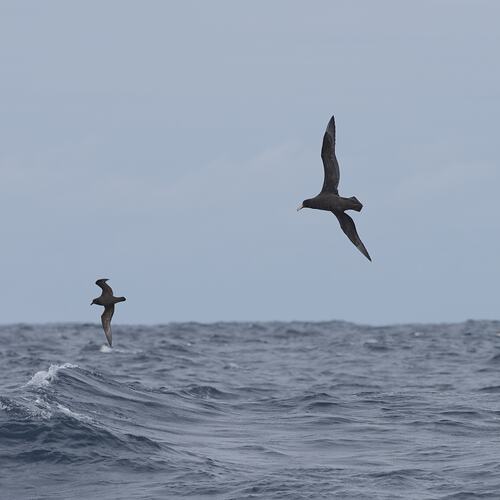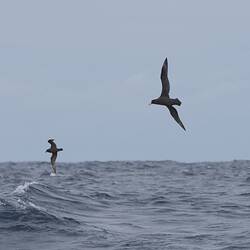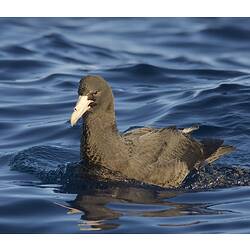General Description
Mature Southern giant petrels are grey-brown to dark brown often with a faded and mottled-white head, neck and breast. It has a massive straw coloured bill with greenish tip and a large single nostril-tube. The underwing has a pale leading edge, near the body, which should aid in discrimination from the Northern Giant Petrel, in which this area is dark brown. Hybrids of Northern and Southern Petrels share features of both. Body to 90 cm, wingspan to 205 cm.
Biology
The southern giant petrel achieves sexual maturity at six or seven years of age. It breeds annually producing a single egg each season. The nest is usually a mound of moss, grass, stones and bones with a depression in the centre and is located on bare or grassy ground. The Southern Giant Petrel is an opportunist scavenger and predator. It primarly eats penguins and smaller seabirds, whale and seal carrion, albatross, squid, fish and krill. They winter in south-eastern Australian and Tasmanian waters.
Distribution
Throughout the Southern Ocean most commonly occuring in Antarctic waters. Regularly seen in south-eastern Australian and Tasmanian waters over winter.
Habitat
Marine: Antarctic to subtropical waters.
More Information
-
Animal Type
-
Animal SubType
-
Brief Id
Large dark brown to grey seabird with a massive straw coloured bill with a greenish tip and a large single nostril-tube. Underwing has pale leading edge.
-
Colours
Brown, Grey, White
-
Maximum Size
90 cm
-
Habitats
-
Diet
Carnivore
-
Diet Categories
Birds, Squid, Mammals, Fish, Krill
-
Endemicity
-
Commercial
No
-
Conservation Statuses
CITES: Not listed, FFG Threatened List: Endangered, EPBC Act 1999: Endangered, IUCN Red List: Least Concern
-
Water Column Locations
Above surface
-
Taxon Name
-
Common Name
Southern Giant-Petrel
-
Kingdom
-
Phylum
-
Subphylum
-
Class
-
Order
-
Family
-
Genus
-
Species Name
giganteus



